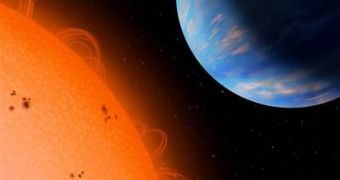The new exo-planet, dubbed GJ 436c, moves in an orbit around the star GJ 436, located in the Leo constellation, 30 light years away from Earth. Relying on the mass of the planet, scientists believe that it could be a rocky planet, about five times heavier than our own. The discovery was made by researchers from the University College London in collaboration with the Spanish Research Council.
GJ 436c completes an orbit around its parent star in about 5.2 days, while a rotation about its axis requires only 4.2 days, opposed to our planet, which orbits the Sun once every 365 days and has a revolution of only 24 hours. The length of Earth's day is closely related to its rotation around its own axis; however, this is not available for GJ 436c, since a full day takes about 22 Earth days, or 4 planetary years.
GJ 436 was already known to bear a small inner exo-planet, albeit further investigation into its orbital movement revealed gravitational perturbations which could only be explained through the presence of another planet, GJ 436c, in resonance with the one already known, meaning that, for every two orbits around the parent star, GJ 436c would complete one orbit.
"After final confirmation, the new exo-planet will be the smallest found to date. It is the first one to be identified from the perturbations exerted on another planet of the system. Because of this, the study opens a new path that should lead to the discovery of even smaller planets in the near future, with the goal of eventually finding worlds more and more similar to the Earth," said Spanish Research Council researcher and leader of the study Ignasi Ribas.
University of College London astrophysicist Dr Jean-Philippe Beaulieu reveals that GJ 436c is the fourth rocky exo-planet ever discovered. The previously detected super-Earth planets were found through gravitational microlensing techniques or Doppler wobble, being named OGLE-2005-BLG-390lb, respectively G1 581b and G1 876d.
"Calculations indicate that the temperature of the planet could be within 400-700 Kelvin, but it could locally be as low as 350 Kelvin at the poles, depending on the type of atmosphere," said Dr Giovanna Tinetti from University College London's Physics and Astronomy.
GJ 436c is currently believed to be the smallest exo-planet ever discovered.

 14 DAY TRIAL //
14 DAY TRIAL //